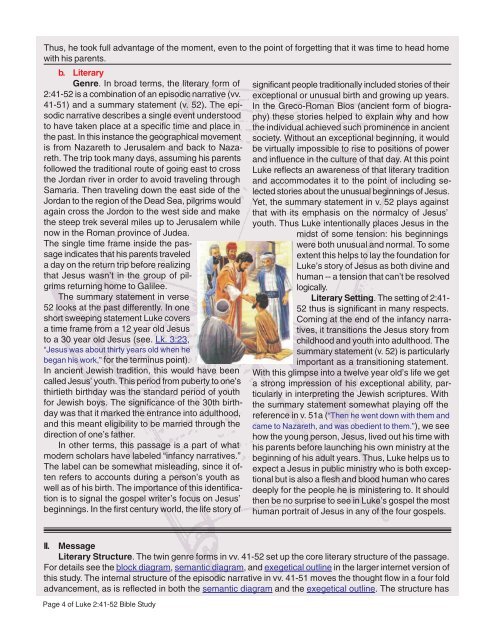Luke 2:41-52 - Lorin
Luke 2:41-52 - Lorin
Luke 2:41-52 - Lorin
Create successful ePaper yourself
Turn your PDF publications into a flip-book with our unique Google optimized e-Paper software.
Thus, he took full advantage of the moment, even to the point of forgetting that it was time to head home<br />
with his parents.<br />
b. Literary<br />
Genre. In broad terms, the literary form of<br />
2:<strong>41</strong>-<strong>52</strong> is a combination of an episodic narrative (vv.<br />
<strong>41</strong>-51) and a summary statement (v. <strong>52</strong>). The episodic<br />
narrative describes a single event understood<br />
to have taken place at a specific time and place in<br />
the past. In this instance the geographical movement<br />
is from Nazareth to Jerusalem and back to Nazareth.<br />
The trip took many days, assuming his parents<br />
followed the traditional route of going east to cross<br />
the Jordan river in order to avoid traveling through<br />
Samaria. Then traveling down the east side of the<br />
Jordan to the region of the Dead Sea, pilgrims would<br />
again cross the Jordon to the west side and make<br />
the steep trek several miles up to Jerusalem while<br />
now in the Roman province of Judea.<br />
The single time frame inside the passage<br />
indicates that his parents traveled<br />
a day on the return trip before realizing<br />
that Jesus wasn’t in the group of pilgrims<br />
returning home to Galilee.<br />
The summary statement in verse<br />
<strong>52</strong> looks at the past differently. In one<br />
short sweeping statement <strong>Luke</strong> covers<br />
a time frame from a 12 year old Jesus<br />
to a 30 year old Jesus (see. Lk. 3:23,<br />
“Jesus was about thirty years old when he<br />
began his work,” for the terminus point).<br />
In ancient Jewish tradition, this would have been<br />
called Jesus’ youth. This period from puberty to one’s<br />
thirtieth birthday was the standard period of youth<br />
for Jewish boys. The significance of the 30th birthday<br />
was that it marked the entrance into adulthood,<br />
and this meant eligibility to be married through the<br />
direction of one’s father.<br />
In other terms, this passage is a part of what<br />
modern scholars have labeled “infancy narratives.”<br />
The label can be somewhat misleading, since it often<br />
refers to accounts during a person’s youth as<br />
well as of his birth. The importance of this identification<br />
is to signal the gospel writer’s focus on Jesus’<br />
beginnings. In the first century world, the life story of<br />
Page 4 of <strong>Luke</strong> 2:<strong>41</strong>-<strong>52</strong> Bible Study<br />
significant people traditionally included stories of their<br />
exceptional or unusual birth and growing up years.<br />
In the Greco-Roman Bios (ancient form of biography)<br />
these stories helped to explain why and how<br />
the individual achieved such prominence in ancient<br />
society. Without an exceptional beginning, it would<br />
be virtually impossible to rise to positions of power<br />
and influence in the culture of that day. At this point<br />
<strong>Luke</strong> reflects an awareness of that literary tradition<br />
and accommodates it to the point of including selected<br />
stories about the unusual beginnings of Jesus.<br />
Yet, the summary statement in v. <strong>52</strong> plays against<br />
that with its emphasis on the normalcy of Jesus’<br />
youth. Thus <strong>Luke</strong> intentionally places Jesus in the<br />
midst of some tension: his beginnings<br />
were both unusual and normal. To some<br />
extent this helps to lay the foundation for<br />
<strong>Luke</strong>’s story of Jesus as both divine and<br />
human -- a tension that can’t be resolved<br />
logically.<br />
Literary Setting. The setting of 2:<strong>41</strong>-<br />
<strong>52</strong> thus is significant in many respects.<br />
Coming at the end of the infancy narratives,<br />
it transitions the Jesus story from<br />
childhood and youth into adulthood. The<br />
summary statement (v. <strong>52</strong>) is particularly<br />
important as a transitioning statement.<br />
With this glimpse into a twelve year old’s life we get<br />
a strong impression of his exceptional ability, particularly<br />
in interpreting the Jewish scriptures. With<br />
the summary statement somewhat playing off the<br />
reference in v. 51a (“Then he went down with them and<br />
came to Nazareth, and was obedient to them.”), we see<br />
how the young person, Jesus, lived out his time with<br />
his parents before launching his own ministry at the<br />
beginning of his adult years. Thus, <strong>Luke</strong> helps us to<br />
expect a Jesus in public ministry who is both exceptional<br />
but is also a flesh and blood human who cares<br />
deeply for the people he is ministering to. It should<br />
then be no surprise to see in <strong>Luke</strong>’s gospel the most<br />
human portrait of Jesus in any of the four gospels.<br />
II. Message<br />
Literary Structure. The twin genre forms in vv. <strong>41</strong>-<strong>52</strong> set up the core literary structure of the passage.<br />
For details see the block diagram, semantic diagram, and exegetical outline in the larger internet version of<br />
this study. The internal structure of the episodic narrative in vv. <strong>41</strong>-51 moves the thought flow in a four fold<br />
advancement, as is reflected in both the semantic diagram and the exegetical outline. The structure has
















